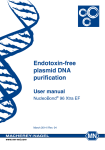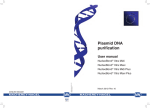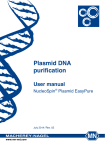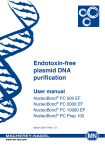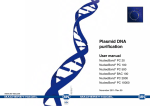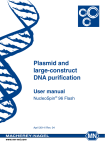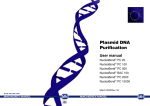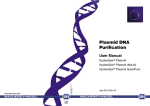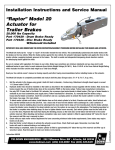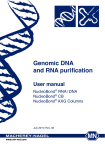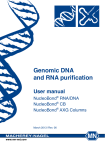Download NucleoBond® Xtra BAC - MACHEREY
Transcript
Large construct DNA purification User manual NucleoBond® Xtra BAC March 2014 / Rev. 02 Large construct DNA purification (NucleoBond® Xtra BAC) Protocol-at-a-glance (Rev. 02) 1 Prepare a starter culture 2 Prepare a large overnight culture 3 Harvest bacterial cells 4 Resuspension 60 mL Buffer RES-BAC 5 Cell lysis (Important: Check Buffer LYS-BAC for precipitated SDS) 60 mL Buffer LYS-BAC 6 Equilibration of the column and filter 30 mL Buffer EQU-BAC 7 Neutralization 60 mL Buffer NEU-BAC 4,500–6,000 x g ≥ 10 min at 4 °C Invert the tube 5 times RT, 5 min Invert the tube 10–15 times, until sample turnes colorless 0 °C / on ice, ≥ 5 min 8 Clarification and loading of the lysate Invert the tube 3 times Load lysate on NucleoBond® Xtra BAC Column Filter 9 Wash column filter and column 15 mL Buffer EQU-BAC 10 Discard column filter 11 Wash column 45 mL Buffer WASH-BAC 12 Elution 15 mL Buffer ELU-BAC 13 Precipitation Discard NucleoBond® Xtra BAC Column Filter 65–70 °C 6 mL isopropanol RT, 2 min 15,000 x g 30 min at 4 °C 14 Wash and dry DNA pellet 5 mL 70 % ethanol 15,000 x g 5 min at RT 10–15 min 15 Reconstitute DNA Appropriate volume of TE buffer or sterile H2O (pH ≥ 7) MACHEREY-NAGEL GmbH & Co. KG · Neumann-Neander-Str. 6–8 · 52355 Düren · Germany Tel.: +49 24 21 969-270 · Fax: +49 24 21 969-199 · [email protected] · www.mn-net.com Large construct DNA purification Table of contents 1 Components 4 1.1 Kit contents 4 1.2 Reagents and equipment to be supplied by user 5 2 Kit specifications 6 3 About this user manual 7 4NucleoBond® Xtra BAC plasmid purification system 8 4.1 Basic principle 8 4.2NucleoBond® Xtra BAC anion-exchange columns 8 4.3 Growth of bacterial cultures 10 4.4 Chloramphenicol amplification of low-copy plasmids 11 4.5 Culture volume for large constructs 12 4.6 Lysate neutralization and LyseControl 12 4.7 Cell lysis 13 4.8 Difficult-to-lyse strains 14 ® 14 4.9 Setup of NucleoBond Xtra BAC Columns 4.10 Filtration and loading of the lysate 15 4.11 Washing of the column 15 4.12 Elution of large construct DNA 16 4.13 Concentration of large construct DNA 16 4.14 Determination of DNA yield and quality 16 4.15 Convenient stopping points 17 5 Storage conditions and preparation of working solutions 18 6 Safety instructions 19 7NucleoBond® Xtra BAC purification 21 8 Appendix 26 8.1 Troubleshooting 26 8.2 Ordering information 33 8.3 Product use restriction / warranty 34 MACHEREY-NAGEL – 03 / 2014, Rev. 02 3 Large construct DNA purification 1 Components 1.1 Kit contents NucleoBond® Xtra BAC 10 preps 25 preps 740436.10 740436.25 Buffer RES-BAC 750 mL 2 x 1000 mL Buffer LYS-BAC 750 mL 2 x 1000 mL Buffer NEU-BAC 750 mL 2 x 1000 mL Buffer EQU-BAC 500 mL 1000 mL 500 mL Buffer WASH-BAC 500 mL 1000 mL 250 mL Buffer ELU-BAC 200 mL 500 mL RNase A* (lyophilized) 75 mg 2 x 100 mg NucleoBond® Xtra BAC Columns incl. NucleoBond® Xtra BAC Column Filters 10 25 Plastic Washers 5 10 User manual 1 1 REF * For preparation of working solutions and storage conditions see section 5. 4 MACHEREY-NAGEL – 03 / 2014, Rev. 02 Large construct DNA purification 1.2 Reagents and equipment to be supplied by user Reagents • Isopropanol (room-temperatured) • Buffer for reconstitution of DNA, for example, TE buffer or sterile H2O (pH ≥ 7) • 70 % ethanol (room-temperatured) Equipment • Standard microbiological equipment for growing and harvesting bacteria (e.g., inoculating loop, culture tubes and flasks, 37 °C shaking incubator, and centrifuge with rotor and tubes or bottles for harvesting cells) • Refrigerated centrifuge capable of reaching ≥ 5,000 x g with rotor for the appropriate centrifuge tubes or bottles • • Centrifugation tubes or vessels with suitable capacity for the volumes specified in the respective protocol NucleoBond® Xtra Combi Rack (see ordering information) or equivalent holder MACHEREY-NAGEL – 03 / 2014, Rev. 02 5 Large construct DNA purification 2 6 Kit specifications • NucleoBond® Xtra BAC is designed for ultra fast purification of cosmids and very large constructs (P1, BACs, PACs) ranging from 3 kbp up to 300 kbp. For preparation of working solutions and storage conditions see section 5. • NucleoBond® Xtra BAC Columns are polypropylene columns containing NucleoBond® Xtra BAC Silica Resin packed between two inert filter elements. The columns offer a binding capacity of 200 μg for very large constructs. • All NucleoBond® Xtra BAC Columns are resistant to organic solvents such as alcohol, chloroform, and phenol and are also suitable for buffers containing denaturing agents like formamide, urea, or common detergents like Triton X-100 or NP-40. • NucleoBond® Xtra BAC Silica Resin can be used over a wide pH range (pH 2.5–8.5), and can remain in contact with buffers for several hours without any change in its chromatographic properties. • The NucleoBond® Xtra BAC Column Filters are specially designed depth filters that fit into the NucleoBond® Xtra BAC Columns. These filters are inserted and ready-to-use in the NucleoBond® Xtra BAC Columns. This allows for a time-saving, simultaneous clearing of bacterial lysate and loading of cleared lysate onto the NucleoBond® Xtra BAC Column. As a result, the time-consuming centrifugation step for lysate clearing is avoided. • The NucleoBond® Xtra BAC Column Filters allow complete removal of precipitate without clogging (even with large lysate volumes), and also avoid shearing of large DNA constructs, such as PACs or BACs. • LyseControl: The Lysis Buffer LYS-BAC contains a blue pH indicator to ensure complete neutralization for maximum yield. MACHEREY-NAGEL – 03 / 2014, Rev. 02 Large construct DNA purification 3 About this user manual Section 4 provides you with a detailed description of the NucleoBond® Xtra BAC purification system and important information about cell growth, cell lysis, and the subsequent purification steps. In addition, sections 5 and 6 inform you about storage, buffer preparation, and safety instructions. First-time users are strongly advised to read these chapters thoroughly before using this kit. Experienced users can directly proceed with the purification protocol (section 7) or just use the Protocol-at-a-glance for a quick reference. Each procedural step in the purification protocol is arranged like the following example taken from section 7: 5 Cell lysis (Buffer LYS-BAC) Check Lysis Buffer LYS-BAC for precipitated SDS prior to use. If a white precipitate is visible, warm the buffer for several minutes at 30–40 °C until precipitate is completely dissolved. Then, proceed to cool the buffer down to room temperature (18–25 °C). Add Lysis Buffer LYS-BAC to the suspension. Mix gently by inverting the tube 5 times. Do not vortex as this will shear and release contaminating chromosomal DNA from cellular debris into the suspension. Incubate the mixture at room temperature (18–25 °C) for 5 min. Warning: Prolonged exposure to alkaline conditions can irreversibly denature and degrade large construct DNA and liberate contaminating chromosomal DNA into the lysate. Note: Increase LYS-BAC buffer volume proportionally if more than the recommended cell mass is used (see section 4.7 for information on optimal cell lysis). 60 mL You will find volumes or incubation times in the white boxes. The name of the buffer, as well as incubation times, repeats or important handling steps, are emphasized in bold type within the instructions. Additional notes or optional steps are printed in italic. The exclamation point marks information and hints that are essential for a successful preparation. In the example shown above you are asked to check the Lysis Buffer LYS-BAC prior to use and then to lyse the resuspended cell pellet in 60 mL of Buffer LYS-BAC. Follow the handling instructions exactly and note the given hints for protocol alterations. MACHEREY-NAGEL – 03 / 2014, Rev. 02 7 Large construct DNA purification 4 NucleoBond® Xtra BAC plasmid purification system 4.1 Basic principle The bacterial cells are lysed by an optimized set of newly formulated buffers based on the NaOH / SDS lysis method of Birnboim and Doly*. After equilibration of the NucleoBond® Xtra BAC Column together with the corresponding NucleoBond® Xtra BAC Column Filter, the entire lysate is loaded by gravity flow and simultaneously cleared by the specially designed column filter. Plasmid DNA is bound to the NucleoBond® Xtra BAC Silica Resin. Upon completion of the washing step, the plasmid DNA is eluted, precipitated, and easily dissolved in any suitable buffer (e.g., low-salt buffer or water) for further use. 4.2 NucleoBond® Xtra BAC anion-exchange columns NucleoBond® Xtra BAC is a patented silica-based anion-exchange resin developed by MACHEREY-NAGEL. It is developed for routine separation of different classes of nucleic acids such as oligonucleotides, RNA, plasmids, and large constructs like P1, BAC, or PAC. NucleoBond® Xtra BAC Silica Resin consists of hydrophilic, macroporous silica beads functionalized with MAE (methyl-amino-ethanol). The dense coating of this functional group provides a high positive charge density under acidic pH conditions. As a result, this permits the negatively charged phosphate backbone of plasmid DNA to bind with high specificity (Figure 1). CH3 Si spacer anion-exchanger group MAE NH O OH bi nd in g CH2 O O O P DNA backbone O Figure 1: Ionic interaction of the positively charged methyl-hydroxyethyl-amino group with the negative phosphate oxygen of the DNA backbone. In contrast to the widely used DEAE (diethylaminoethyl) group, the hydroxy group of methyl-hydroxyethyl-amin can be involved in additional hydrogen bonding interactions with the DNA. * Birnboim, H. C. and Doly, J., (1979) Nucl. Acids Res. 7, 1513-1523 8 MACHEREY-NAGEL – 03 / 2014, Rev. 02 Large construct DNA purification Due to a specialized manufacturing process, that is strictly controlled and monitored, the NucleoBond® Xtra BAC silica beads are uniform in diameter and contain particularly large pores. These special properties allow optimized flow rates and sharp, well-defined elution profiles. NucleoBond® Xtra BAC can separate distinct nucleic acid species from each other as well as proteins, carbohydrates, and other unwanted cellular components over a broad range of salt concentrations (Figure 2). All contaminants from proteins to RNA are washed from the column. Then, the positive charge of the resin is neutralized by a pH shift to slightly alkaline conditions and pure plasmid DNA is eluted in a high-salt elution buffer. The purified nucleic acid products are suitable for use in the most demanding molecular biology applications, including transfection, in vitro transcription, automated or manual sequencing, cloning, hybridization, and PCR. Plasmid DNA, large constructs Compound class Single-stranded DNA, Double-stranded DNA mRNA, 16S/23S rRNA 5S rRNA tRNA tRNA Absorbance at 260 nm rRNA Plasmid DNA, large constructs Proteins, dyes, polysaccharides, metabolites, trinucleotides 0 0.5 1 1.5 Salt concentration for elution [M (KCl)] Figure 2: Elution profile of NucleoBond® Xtra BAC Silica Resin at pH 7.0 The more interactions a nucleic acid can form between the phosphate backbone and the positively charged resin, the later it is eluted with increasing salt concentration. Large nucleic acids carry more charges than smaller ones and double stranded DNA carries more than single stranded RNA. MACHEREY-NAGEL – 03 / 2014, Rev. 02 9 Large construct DNA purification 4.3 Growth of bacterial cultures Yield and quality of large construct DNA highly depend on several factors: type of culture media and antibiotics, the bacterial host strain, the type of DNA, size, and copy number, but also on the growth conditions. For large constructs, like BAC, PAC, P1, or cosmid DNA, LB (Luria-Bertani) medium is strongly recommended. The cell culture should be grown to an OD600 of 1.5–2.0 to prevent starvation of the cells and degradation of large constructs. Therefore, incubate at 32–37 °C preferably 12–16 hours overnight. Use flasks of at least three or four times the volume of the culture volume and shake at 120–250 rpm to provide a growth medium fully saturated with oxygen. Alternatively to LB, rich media like 2xYT (Yeast/Tryptone), TB (Terrific Broth), or CircleGrow can be used. In this case, bacteria grow faster, reaching the stationary phase much earlier than in LB medium (≤ 12 h), and reach higher cell masses. However, this does not necessarily yield more DNA. Overgrowing a culture might lead to a higher percentage of dead or starving cells and the resulting BAC, PAC, P1, or cosmid DNA might be partially degraded or contaminated with chromosomal DNA. To find the optimal culture conditions, the culture medium and incubation times have to be optimized for each host strain / large construct combination individually. Cell cultures should be grown under antibiotic selection at all times to ensure large construct DNA propagation. Without this selective pressure, cells tend to lose a large construct during cell division. Since bacteria grow much faster without the burden of an additional chromosome, they take over the culture rapidly and the yield goes down regardless of the cell mass. Table 1 gives information on concentrations of commonly used antibiotics. Table 1: Information about antibiotics according to Maniatis* Antibiotic Stock solution (concentration) Storage Working concentration Ampicillin 50 mg / mL in H2O - 20 °C 50–100 μg / mL Chloramphenicol 34 mg / mL in EtOH - 20 °C 25–170 μg / mL Kanamycin 10 mg / mL in H2O - 20 °C 10–50 μg / mL Streptomycin 10 mg / mL in H2O - 20 °C 10–50 μg / mL Tetracycline 5 mg / mL in EtOH - 20 °C 10–50 μg / mL Carbenicillin 50 mg / mL in H2O - 20 °C 20–60 μg / mL * Maniatis T, Fritsch EF, Sambrook J: Molecular cloning. A laboratory manual, Cold Spring Harbor, Cold Spring, New York 1982. 10 MACHEREY-NAGEL – 03 / 2014, Rev. 02 Large construct DNA purification The E. coli host strain mostly influences the quality of the large construct DNA. Strains like DH5α or XL1-Blue usually produce high quality super-coiled DNA, whereas strains like HB101, with high levels of endonuclease activity, might yield lower quality large constructs, giving poor results in downstream applications like enzymatic restriction or sequencing. When noticing problems with host strains like Top10, HB101, or its derivatives like TG1, JM100, a change to DH5α or XL1-Blue should be considered. The type of large construct, especially the size and the origin of replication (ori), has a crucial influence on DNA yield. In general, the larger the construct or the cloned insert is, the lower the expected DNA yield is due to a lower copy number. Cosmids or BACs, for example, are maintained at copy numbers < 20 and down to only 1, whereas vectors based on, for example, pUC, pBluescript, or pGEM, can be present in several hundred copies per cell. Thus, all the above mentioned factors should be taken into consideration if a particular DNA yield has to be achieved. Culture volume and lysis procedures have to be adjusted accordingly. The prep to prep variation of yield varies much more compared to highcopy plasmid purification. 4.4 Chloramphenicol amplification of low-copy plasmids To dramatically increase the low copy number of pMB1 / colE1 derived plasmids, grow the cell culture to mid or late log phase (OD600 ≈ 0.6–2.0) under selective conditions with an appropriate antibiotic. Then, add 170 μg/mL chloramphenicol and continue to incubate for an additional 8–12 hours. Chloramphenicol inhibits host protein synthesis and as a result, prevents replication of the host chromosome. Plasmid replication, however, is independent of newly synthesized proteins and continues for several hours until up to 2000–3000 copies per cell are accumulated*. Alternatively, the cell culture can be grown with only partial inhibition of protein synthesis under low chloramphenicol concentrations (10–20 μg/mL), resulting in a 5–10-fold greater yield of plasmid DNA**. Both methods show the positive side effect of much less genomic DNA per plasmid, but they obviously work only with plasmids that do not carry the chloramphenicol resistance gene. Furthermore, the method is only effective with low copy number plasmids under stringent control (e.g., pBR322). All modern high copy number plasmids (e.g., pUC) are already under relaxed control due to mutations in the plasmid copy number control genes, resulting in an insignificant additional increase to their copy number. * Maniatis T, Fritsch EF, Sambrook J: Molecular cloning. A laboratory manual, Cold Spring Harbor, Cold Spring, New York 1982. **Frenkel L, Bremer H: Increased amplification of plasmids pBR322 and pBR327 by low concentrations of chloramphenicol, DNA (5), 539 – 544, 1986. MACHEREY-NAGEL – 03 / 2014, Rev. 02 11 Large construct DNA purification 4.5 Culture volume for large constructs Due to the influence of growth media (TB, CircleGrow, 2xYT), growth conditions (shaking, temperature, incubation time) and host strain or type of insert etc., the final amount of cells in a bacterial culture can vary over a wide range. By rule of thumb, 1 liter of E. coli culture with an OD600 of 1 consists of 1 x 1012 cells and yields about 1.5–1.8 g cell wet weight. Overnight cultures containing a large construct and grown in LB medium usually reach an OD600 of 3 under vigorous shaking in flasks. The expected DNA yield for a large construct is approximately 30–40 μg per gram cell wet weight. As a consequence, it is important to adjust the cell mass rather than the culture volume for the best large construct purification results. However, since the cell mass or cell wet weight is tedious to determine, it was replaced in this manual by the mathematical product of optical density at 600 nm (OD600) and culture volume (Vol), two variables that are much easier to measure. ODV = OD600 x Vol [mL] Please note that for a correct OD determination, the culture samples have to be diluted if the OD600 exceeds 0.5, allowing it to increase proportionally with cell mass. For a well grown E. coli culture, a 1:10 dilution with fresh culture medium is recommended. The measured OD600 is then multiplied with the dilution factor 10 to result in a theoretical OD600 value. This OD600 is used to determine the appropriate culture volume. Table 2 shows recommended ODVs along with the corresponding pairs of OD600 and culture volume that can be easily handled using the standard kit protocol lysis buffer volumes. For example, if the OD600 of your E. coli culture is 2, use 750 mL culture for your BAC preparation Table 2: Recommended culture volumes for large constructs NucleoBond® Xtra BAC Pellet wet weight 2.8 g Rec. ODV = OD600 x Vol OD600 = OD600 = 2 3 1500 750 mL 500 mL 375 mL 300 mL 250 mL Recommended culture volume for OD600 = OD600 = OD600 = 4 5 6 4.6 Lysate neutralization and LyseControl Proper mixing of the lysate with Neutralization Buffer NEU-BAC is of utmost importance for complete precipitation of SDS, protein, and genomic DNA. Incomplete neutralization leads to reduced yields, slower flow-rates, and potential clogging of the NucleoBond® Xtra Column Filter. However, released plasmid DNA and especially large BAC DNA, is very vulnerable at this point and shaking too much or too strongly will damage the DNA. 12 MACHEREY-NAGEL – 03 / 2014, Rev. 02 Large construct DNA purification Therefore, do not vortex or shake but just invert the mixture very gently until a fluffy off-white precipitate has formed and the LyseControl has turned colorless throughout the lysate without any traces of blue color. 4.7 Cell lysis The bacterial cell pellet is resuspended in Buffer RES-BAC and lysed by a sodium hydroxide / SDS treatment with Buffer LYS-BAC. Proteins, as well as chromosomal and large construct DNA, are denatured under these conditions. In addition, RNA is degraded by DNase-free RNase A. Large construct lysates have to be treated even more carefully than plasmid DNA lysates to avoid nicking and irreversible denaturation of the large constructs. As a consequence, shaking or vortexing of the lysate must be avoided. Neutralization Buffer NEU-BAC, containing potassium acetate, is then added to the lysate, causing SDS to precipitate as KDS (potassium dodecyl sulfate) and pull down proteins, chromosomal DNA, and other cellular debris. The potassium acetate buffer also neutralizes the lysate. Circular DNA can revert to its native super-coiled structure and remains in solution. The NucleoBond® Xtra BAC buffer volumes given in the standard protocol are adjusted to ensure optimal lysis for culture volumes given in section 4.5, Table 2. Using too much cell material leads to inefficient cell lysis and precipitation, which can potentially reduce large construct yield and purity. Therefore, lysis buffer volumes should be increased when applying larger culture volumes. By rule of thumb, calculate the necessary lysis buffer volumes for RES-BAC, LYS-BAC, and NEU-BAC as follows: Vol. [mL] = Culture Volume [mL] x OD600 / 25 Note: This formula differs from the one for plasmid DNA to ensure maximum yield for large constructs. For example, if 500 mL of a bacterial culture (OD600 = 3, ODV = 1500) is to be lysed, the appropriate volumes of lysis buffers RES-BAC, LYS-BAC, and NEU-BAC are 60 mL each. If more lysis buffer is needed than is provided with the kit, an additional buffer set including buffers RES-BAC, LYS-BAC, NEU-BAC, and RNase A can be ordered separately (see ordering information). If less than the recommended amount of cells is to be used (e.g., due to bad cell growth or limited culture volumes), less lysis buffer volumes can be used than given in the standard protocol (60 mL each). Calculate the necessary amount according to the above given formula. Note that the yield might then be significantly lower than 200 μg. By using sufficient amounts of lysis buffer, lysis time can be limited to 3–4 minutes and should not exceed 5 minutes. Prolonged exposure to alkaline conditions can irreversibly denature and degrade especially large construct DNA and liberate contaminating chromosomal DNA into the lysate. MACHEREY-NAGEL – 03 / 2014, Rev. 02 13 Large construct DNA purification 4.8 Difficult-to-lyse strains For large construct purification of Gram-positive bacteria or strains with a more resistant cell wall, it might be advantageous to start the preparation with a lysozyme treatment. Proceed to resuspend the cell pellet in Buffer RES-BAC containing 2 mg/mL lysozyme and incubate at 37 °C for 30 minutes. Then, follow the lysis procedure according to the NucleoBond® Xtra BAC standard protocol. 4.9 Setup of NucleoBond® Xtra BAC Columns Ideally, the NucleoBond® Xtra Columns are placed into a NucleoBond® Xtra Combi Rack (see ordering information). They are held either by the collar ring of the cartridges or by the Plastic Washers (included in the kit) to individually adjust the height of each column (see Figure 3). The Plastic Washers can also be used to hold the columns on top of suitable collection tubes or flasks. The NucleoBond® Xtra Combi Rack can be used in combination with NucleoBond® PC 100, 500, and 2000 as well. Note that the NucleoBond® Xtra Midi Columns can also be placed in the NucleoBond® Rack Large (REF 740563). A B Figure 3: Setup of NucleoBond® Xtra Columns with the NucleoBond® Xtra Combi Rack A: Setup for clarification, loading, and first washing step; B: Setup for elution. 14 MACHEREY-NAGEL – 03 / 2014, Rev. 02 Large construct DNA purification 4.10 Filtration and loading of the lysate After the alkaline lysis, the sample has to be cleared from cell debris and precipitate to ensure high plasmid purity and a fast column flow rate. This is achieved by passing the solution through a NucleoBond® Xtra BAC Column Filter which is provided already inserted into the NucleoBond® Xtra BAC Column. NucleoBond® Xtra BAC NucleoBond® Xtra BAC Column Filter NucleoBond® Xtra BAC Column The NucleoBond® Xtra BAC Column Filters are designed to eliminate the centrifugation step after the alkaline lysis. They are pre-wet during column equilibration and allow a time-saving simultaneous clearing of bacterial lysate and loading of the NucleoBond® Xtra BAC Column. Compared to lysate clearing by centrifugation or syringe filters, the NucleoBond® Xtra BAC Column Filter avoids shearing of large DNA constructs such as PACs or BACs by the gentle depth filter effect (filtration occurs on the surface of the filter as well as inside the filter matrix). Its special material and design lead to a very rapid passage of the lysate through the filter and even very large lysate volumes can be applied without the risk of clogging. This is especially important for low-copy plasmid purification. However, if more than the recommended cell mass (see section 4.5, Table 2) was lysed, it might be advantageous to remove the precipitate by centrifugation (10 min, ≥ 5000 x g) before applying the lysate to the column filter. 4.11 Washing of the column The high salt concentration of the lysate prevents proteins and RNA from binding to the NucleoBond® Xtra BAC Column (see section 4.2, Figure 2). However, to remove all trace amounts of contaminants and to purge the dead volume of the NucleoBond® Xtra BAC Column Filters, it is important to wash the column and the filter in two subsequent washing steps. First, apply the Equilibration Buffer EQU-BAC to the funnel rim of the filter to wash all residual lysate out of the filter and onto the column. Do not just pour the buffer inside the filter. Then, pull out and discard the column filter or remove the filter by turning the column upside down. It is essential to wash the NucleoBond® Xtra BAC Column MACHEREY-NAGEL – 03 / 2014, Rev. 02 15 Large construct DNA purification without the filter for a second time with Wash Buffer WASH-BAC. This ensures highest yields with best achievable purity. 4.12 Elution of large construct DNA Elution is carried out under high-salt conditions and by a shift of pH from 6.3 to 8.5. Under these alkaline conditions, the positive charge of the anion-exchange resin is neutralized and large construct DNA is released. To facilitate the dissociation of large construct DNA from the resin, ELU-BAC should be heated to 65–70 °C. The elution efficiency can be increased further by preventing the elution buffer from cooling down too fast. Therefore, either incubate the column at 50–60 °C during elution or apply the elution buffer in smaller 1–2 mL portions (heated to 65–70 °C). 4.13 Concentration of large construct DNA For any downstream application it is necessary to precipitate the DNA and to remove salt and all traces of alcohol since they disturb or inhibit enzymatic activity needed for restriction or sequencing reactions. All NucleoBond® Xtra BAC eluates already contain enough salt for an isopropanol precipitation of DNA. As a result, the precipitation is started by directly adding 0.4 volumes of isopropanol. To prevent co-precipitation of salt, use room-temperature (18–25 °C) isopropanol only and do not let the large construct DNA solution drop into a vial with isopropanol. Instead, add the isopropanol to the final eluate and mix immediately. DNA is then collected by centrifugation and washed with 70 % ethanol according to the standard protocol. Attention should be paid to the drying step. It is very important that all liquid is pipetted off and allowed to evaporate completely at room temperature to reduce contamination of large construct DNA with ethanol. However, any over-drying will result in the DNA being harder to dissolve and should be avoided. To dissolve large constructs completely, incubate in an appropriate volume of buffer at 4 °C overnight. Use only wide bore pipette tips (with a large opening), or cut the tip to increase the opening to prevent large constructs from shearing. Concentration of BAC, PAC, or P1 constructs with NucleoBond® Finalizer or Finalizer Large is not recommended. The recovery drops with increasing size of the construct due to tighter binding of large DNA to the NucleoBond® Finalizer membrane (Use of NucleoBond® Finalizer is only recommended for vector sizes smaller than 50 kbp)! 4.14 Determination of DNA yield and quality The yield of a large construct DNA preparation should be estimated prior to and after the isopropanol precipitation in order to calculate the recovery after precipitation and to find the best volume to dissolve the pellet in. Simply use either NucleoBond® Xtra 16 MACHEREY-NAGEL – 03 / 2014, Rev. 02 Large construct DNA purification BAC Elution Buffer ELU-BAC or the respective low-salt buffer as a blank in your photometric measurement. The nucleic acid concentration of the sample can be calculated from its UV absorbance at 260 nm where an absorbance of 1 (1 cm path length) is equivalent to 50 μg DNA / mL. Note that the absolute measured absorbance should lie between 0.1 and 0.7 in order to be in the linear part of Lambert-Beer´s law. Dilute your sample in the respective buffer if necessary. The plasmid purity can also be checked by UV spectroscopy. A ratio of A260/A280 between 1.80–1.90 and an A260/A230 around 2.0 indicates pure plasmid DNA. An A260/ A280 ratio above 2.0 is a sign for too much RNA in your preparation, and an A260/A280 ratio below 1.8 indicates protein contamination. Note that agarose gels can resolve DNA of different sizes only to an upper limit of 20–30 kbp. A a result, standard agarose gels are not suitable to assess the quality of BAC DNA. Large constructs and genomic DNA fragments run more or less at the same speed and will appear in one broad band. Sometimes additional, slower running bands can be observed or DNA is stuck in the gel slot and does not run at all. These are mostly conformational isomers or DNA that was denatured during the purification. This DNA is usually large construct DNA, or the same mix of large construct and genomic DNA as the main band, and does not indicate a very high contamination with genomic DNA. Large constructs like BAC, can be distinguished from genomic DNA on agarose gels only by Pulse Field Gel Electrophoresis. This system has a constantly changing electrical field that leads to different migration speeds of DNA larger than 30 kbp. Alternatively, the DNA can be restricted, for example with BamHI, EcoRI, or HindIII, and analyzed on a 0.7 % TAE agarose gel. The large construct DNA with only few restriction sites show a ladder of distinct bands, whereas the genomic DNA might be visible as a continuous smear in the background. 4.15 Convenient stopping points Cell pellets can easily be stored for several months at - 20 °C. Cleared lysates can be kept on ice or at 4 °C for several days. For optimal performance, the column purification should not be interrupted. However, the columns can be left unattended for several hours since the columns do not run dry, causing only small losses in DNA yield. The eluate can be stored for several days at 4 °C. Note that the eluate should be warmed up to room temperature before precipitating the DNA to avoid co-precipitation of salt. MACHEREY-NAGEL – 03 / 2014, Rev. 02 17 Large construct DNA purification 5 Storage conditions and preparation of working solutions Storage conditions and preparation of working solutions All kit components can be stored at room temperature (18–25 °C) and are stable for at least two years. Before you start any NucleoBond® Xtra BAC purification prepare the following: • Dissolve the lyophilized RNase A* of one vial by the addition of 1 mL of Buffer RES-BAC. Wearing gloves is recommended. Pipette up and down until the RNase A is dissolved completely. Transfer the RNase A solution back to the bottle containing Buffer RES-BAC and shake well. Note the date of RNase A addition. The final concentration of RNase A is 100 μg / mL Buffer RES-BAC. Store Buffer RES-BAC with RNase A at 4 °C. The solution will be stable at this temperature for at least 6 months. • Buffer LYS-BAC should be stored at room temperature (18–25 °C) since the containing SDS might precipitate at temperatures below 20 °C. If precipitation is observed, incubate the bottle for several minutes at about 30–40 °C and mix well until the precipitate is completely redissolved. * REF 740436.25 contains 2 x 100 mg of RNase A. Make sure to dissolve RNase A of both vials, each in 1 mL of Buffer RES-BAC, and transfer the solution back into the bottle containing Buffer RES-BAC. 18 MACHEREY-NAGEL – 03 / 2014, Rev. 02 Large construct DNA purification 6 Safety instructions The following components of the NucleoBond® Xtra BAC kits contain hazardous contents. Wear gloves and goggles and follow the safety instructions given in this section. GHS classification Only harmful features need not be labeled with H and P phrases up to 125 mL or 125 g. Mindergefährliche Eigenschaften müssen bis 125 mL oder 125 g nicht mit H- und P-Sätzen gekennzeichnet werden. Component Hazard contents GHS symbol Hazard Precaution phrases phrases Inhalt Gefahrstoff GHS Symbol H-Sätze P-Sätze LYS-BAC Sodium hydroxide < 2 % Warning Achtung 290, 315, 319 234, 280, 302+352, 305+351+338, 332+313, 337+313, 390, 406 EQU-BAC Buffer salts + ethanol 5–20% Warning 226 210, 233, 403+235 Puffersalze + Ethanol 5–20% Achtung Buffer salts + ethanol 5–20% Warning 226 Puffersalze + Ethanol 5–20% Achtung 210, 233, 403+235 Buffer salts + isopropanol 10–15% Warning 226, 319 Puffersalze + Isopropanol 10–15% Achtung 210, 233, 280, 305+351+338, 337+313, 403+235 RNase A, lyophilized Danger 317, 334 261, 280, 302+352, 304+341, 333+313, 342+311, 363 WASH-BAC ELU-BAC RNase A Natriumhydroxid < 2 % RNase A, lyophilisiert Gefahr Hazard phrases H 226 Flammable liquid and vapour. H 290 May be corrosive to metals. H 315 Causes skin irritation. H 317 May cause an allergic skin reaction. H 319 Causes serious eye irritation. H 334 May cause allergy or asthma symptoms or breathing difficulties if inhaled. Flüssigkeit und Dampf entzündbar. Kann gegenüber Metallen korrosiv sein. Verursacht Hautreizungen. Kann allergische Hautreaktionen verursachen. Verursacht schwere Augenreizung. MACHEREY-NAGEL – 03 / 2014, Rev. 02 19 Large construct DNA purification Kann bei Einatmen Allergie, asthmaartige Symptome oder Atembeschwerden verursachen. Precaution phrases P 210 Keep away from heat, hot surfaces, sparks, open flames and other ignition sources. No smoking. Von Hitze, heißen Oberflächen, Funken, offenen Flammen sowie anderen Zündquellenarten fernhalten. Nicht rauchen. P 233 Keep container tightly closed. P 234 Keep only in original container. P 261 Avoid breathing dust. P 280 Wear protective gloves / eye protection. P 302+352 IF ON SKIN: Wash with plenty of water/… P 304+341 IF INHALED: If breathing is difficult, remove to fresh air and keep at rest in a position comfortable for breathing. Behälter dicht verschlossen halten. Nur im Originalbehälter aufbewahren. Einatmen von Staub vermeiden. Schutzhandschuhe / Augenschutz tragen. BEI KONTAKT MIT DER HAUT: Mit viel Wasser/… waschen. Bei Einatmen: Bei Atembeschwerden an die frische Luft bringen und in einer Position ruhigstellen, die das Atmen erleichtert. P 305+351+338 IF IN EYES: Rinse continuously with water for several minutes. Remove contact lenses if present and easy to do – continue rinsing. BEI KONTAKT MIT DEN AUGEN: Einige Minuten lang behutsam mit Wasser spülen. Vorhandene Kontaktlinsen nach Möglichkeit entfernen. Weiter spülen. P 332+313 IF skin irritation occurs: Get medical advice / attention. P 333+313 If skin irritation occurs: Get medical advice / attention. P 337+313 Get medical advice / attention P 342+311 If experiencing respiratory symptoms: Call a POISON CENTER or doctor / physician. P 363 Wash contaminated clothing before reuse P 390 Absorb spillage to prevent material damage. P 403+235 Store in a well ventilated place. Keep cool. P 406 Store in a corrosive resistant /… container with a resistant inner liner. Bei Hautreizung: Ärztlichen Rat einholen / ärztliche Hilfe hinzuziehen. Bei Hautreizung: Ärztlichen Rat einholen / ärztliche Hilfe hinzuziehen. Bei anhaltender Augenreizung: Ärztlichen Rat einholen / ärztliche Hilfe hinzuziehen. Bei Symptomen der Atemwege: GIFTINFORMATIONSZENTRUM oder Arzt anrufen. Kontaminierte Kleidung vor erneutem Tragen waschen. Verschüttete Mengen aufnehmen, um Materialschäden zu vermeiden. Kühl an einem gut belüfteten Ort aufbewahren. In korrosionsbeständigem / (...) Behälter mit korrosionsbeständiger AUskleidung aufbewahren. For further information please see Material Safety Data Sheets (www.mn-net.com). Weiterführende Informationen finden Sie in den Sicherheitsdatenblättern (www.mn-net.com). 20 MACHEREY-NAGEL – 03 / 2014, Rev. 02 NucleoBond® Xtra BAC 7 1 NucleoBond® Xtra BAC purification Prepare a starter culture Inoculate a 3–5 mL starter culture of LB medium with a single colony picked from a freshly streaked agar plate. Make sure that plate and liquid culture contain the appropriate selective antibiotic to guarantee large construct propagation (see section 4.3 for more information). Shake at 32–37 °C and ~ 300 rpm for ~ 8 h. 2 Prepare a large overnight culture Inoculate two 250 mL overnight cultures in 1000 mL Erlenmeyer flasks by diluting the starter culture 1/1000 into the given volumes of LB medium also containing the appropriate selective antibiotic. Refer to section 4.5 for larger culture volumes if the cultures are known to grow poorly. Grow the cultures overnight at 32–37 °C and 200–250 rpm for 12–16 h. Note: To utilize the entire large binding capacity of the NucleoBond® Xtra BAC Columns, it is important to provide enough large construct DNA. If you are not sure about the large construct copy number and growth behavior of your host strain, increase the culture volume and decide in step 3 how much cells to use for the preparation. The culture volume recommended below is calculated for a final OD600 of around 3 and should yield around 100 μg of large construct DNA (see to section 4.5 for more information). 2 x 250 mL 3 Harvest bacterial cells Measure the cell culture OD600 and determine the recommended culture volume. V [mL] = 1500 / OD600 Pellet the cells by centrifugation at 4,500–6,000 x g for ≥ 10 min at 4 °C and discard the supernatant completely. Note: It is of course possible to use more than the recommended amount of cells. In this case increase RES-BAC, LYS-BAC and NEU-BAC buffer volumes proportionally in steps 4, 5, and 7 (see section 4.7 for more information). Additional lysis buffer might have to be ordered separately (see ordering information for NucleoBond® Xtra BAC Buffer Set I, section 8.2). It might be necessary to use a centrifuge for the lysate clarification in step 8 rather than the NucleoBond® Xtra BAC Column Filters. MACHEREY-NAGEL – 03 / 2014, Rev. 02 21 NucleoBond® Xtra BAC 4 Resuspension (Buffer RES-BAC) Resuspend the cell pellet completely in Resuspension Buffer RES-BAC + RNase A by pipetting up and down or vortexing the cells. For an efficient cell lysis it is important that no clumps remain in the suspension. Note: Increase RES-BAC buffer volume proportionally if more than the recommended cell mass is used (see section 4.7 for information on optimal cell lysis and section 4.8 regarding difficult-to-lyse strains). 60 mL 5 Cell lysis (Buffer LYS-BAC) Check Lysis Buffer LYS-BAC for precipitated SDS prior to use. If a white precipitate is visible, warm the buffer for several minutes at 30–40 °C until precipitate is completely dissolved. Then, proceed to cool the buffer down to room temperature (18–25 °C). Add Lysis Buffer LYS-BAC to the suspension. Mix gently by inverting the tube 5 times. Do not vortex as this will shear and release contaminating chromosomal DNA from cellular debris into the suspension. Incubate the mixture at room temperature (18–25 °C) for 5 min. Warning: Prolonged exposure to alkaline conditions can irreversibly denature and degrade large construct DNA and liberate contaminating chromosomal DNA into the lysate. Note: Increase LYS-BAC buffer volume proportionally if more than the recommended cell mass is used (see section 4.7 for information on optimal cell lysis). 60 mL 6 Equilibration (Buffer EQU-BAC) Equilibrate a NucleoBond® Xtra BAC Column together with the inserted column filter with Equilibration Buffer EQU-BAC. Apply the buffer onto the rim of the column filter as shown in the picture and make sure to wet the entire filter. Allow the column to empty by gravity flow. The column does not run dry. 22 MACHEREY-NAGEL – 03 / 2014, Rev. 02 NucleoBond® Xtra BAC 30 mL 7 Neutralization (Buffer NEU-BAC) Add Neutralization Buffer NEU-BAC to the suspension and immediately mix the lysate gently by inverting the tube until the blue sample turns colorless. Do not vortex. The flask or tube used for this step should not be filled more than two thirds to allow homogeneous mixing. Make sure to neutralize completely to precipitate all the protein and chromosomal DNA. The lysate should turn from a slimy, viscous consistency to a low viscosity, homogeneous suspension of off-white flocculate. In addition, the LyseControl should turn completely colorless without any traces of blue. Incubate lysate on ice for at least 5 min. Note: Increase NEU-BAC buffer volume proportionally if more than the recommended cell mass is used (see section 4.7 for information on optimal cell lysis). 60 mL 8 Clarification and loading Make sure to have a homogeneous suspension of the precipitate by inverting the tube 3 times before applying the lysate to the equilibrated NucleoBond® Xtra BAC Column Filter, thus avoiding clogging of the filter. Note: If more than twice the recommended cell mass is used, the capacity of the column filter might be too small to hold all the precipitate. In this case, centrifuge the lysate at ≥ 5,000 x g for at least 10 min and load the supernatant to the equilibrated column filter. The lysate is simultaneously cleared and loaded onto the column. Refill the filter if more lysate has to be loaded than the filter is able to hold. Allow the column to empty by gravity flow. Optional: Final yield might be increased by reloading the lysate flow-through a second time, especially if the amount of DNA is close to the binding capacity of the NucleoBond® Xtra BAC Column. MACHEREY-NAGEL – 03 / 2014, Rev. 02 23 NucleoBond® Xtra BAC 9 Wash column filter and column (Buffer EQU-BAC) Wash the NucleoBond® Xtra BAC Column Filter and NucleoBond® Xtra BAC Column with Equilibration Buffer EQU-BAC. Apply the buffer to the funnel shaped rim of the filter and make sure it is washing out the lysate remaining in the filter. Omitting this step or just pouring the buffer directly inside the funnel may reduce plasmid yield. 15 mL 10 Discard column filter Either pull out the NucleoBond® Xtra BAC Column Filter or discard it by turning the column upside down. 11 Wash column (Buffer WASH-BAC) Wash the NucleoBond® Xtra BAC Column with Wash Buffer WASH-BAC. It is important to remove the column filter before applying Buffer Wash-BAC to avoid low purity. 45 mL 12 Elution (Buffer ELU-BAC) Heat Elution Buffer ELU-BAC to 65–70 °C. Remove the waste container and place a 15 mL or 50 mL centrifuge tube (not provided) under the column. Elute the large construct DNA with hot Elution Buffer ELU-BAC. Note: The elution efficiency can be increased by preventing the elution buffer from cooling down to fast. Therefore, either incubate the column at 50–60 °C during elution, or apply the elution buffer in smaller 2–3 mL portions (heated to 65–70 °C). The overall yield can be increased even further by adding a second elution step with an additional 10 mL of hot elution buffer. Determine large construct yield by UV spectrophotometry before precipitating the DNA in order to adjust desired concentration of DNA in step 15 and calculate the recovery after precipitation. 24 MACHEREY-NAGEL – 03 / 2014, Rev. 02 NucleoBond® Xtra BAC 15 mL 13 Precipitation Add 0.4 volumes of room-temperature isopropanol to precipitate the eluted large construct DNA. Vortex well and let the mixture sit for 2 minutes. Centrifuge at ≥ 5,000 x g for ≥ 15 min at ≤ room temperature, preferably at 15,000 x g for 30 min at 4 °C. Carefully discard the supernatant. 6 mL 14 Wash and dry DNA pellet Add room-temperature 70 % ethanol to the pellet and centrifuge at ≥ 5,000 x g, preferably ≥ 15,000 x g for 5 min at room temperature (18–25 °C). 5 mL Carefully remove ethanol completely from the tube with a pipette tip. Allow the pellet to dry at room temperature (18–25 °C). Note: DNA might be harder to dissolve when over-dried. 10–15 min 15 Reconstitute DNA Add an appropriate volume of buffer TE or sterile H2O to dissolve the pellet. Less than 500 μL can be applied if the yield is expected to be very low. 500–1000 μL Ideally, incubate overnight at 4 °C to dissolve BAC DNA completely. Avoid pipetting up and down since large DNA constructs are prone to shearing. Instead, shake the tube gently and use only wide bore pipette tips (with a large opening), or cut the tip to increase the opening. 4 °C over night If the dissolved DNA pellet is very viscous, add more buffer TE or H2O to ensure complete dissolving and a correct quantification. Determine large construct yield by UV spectrophotometry. MACHEREY-NAGEL – 03 / 2014, Rev. 02 25 Large construct DNA purification 8 Appendix 8.1 Troubleshooting If you experience problems with reduced yield or purity, it is recommended to check which purification step of the procedure is causing the problem. First, the bacterial culture has to be checked for sufficient growth (OD600) in the presence of an appropriate selective antibiotic (Table 1, section 4.3). Second, aliquots of the cleared lysate, the flow-through, the combined washing steps (Buffer EQU-BAC and Buffer WASH-BAC), and the eluate should be kept for further analysis by agarose gel electrophoresis. Choose at least 1000 μL of the cleared lysate, flow-through, and combined washing steps as well as 200 μL of the eluate. Precipitate the nucleic acids by adding 0.7 volumes of isopropanol. Centrifuge the samples and wash the pellets using 70 % ethanol. Centrifuge again and remove supernatant. Then, air dry for 10 minutes and dissolve the DNA in 30 μL TE buffer, pH 8.0, and run 20–30 μL on a 1 % agarose gel. The gel picture below (Figure 4) will help you to address the specific questions outlined in the following section more quickly and efficiently. This shows, for example, the dominant large construct bands which should only be present in the eluate and in the lysate before loading, proving that there is large construct production in your cell culture (lane 1). Large construct DNA found in the wash fractions, however, narrows down the problem to wrong or bad wash buffers (e.g., wrong pH, buffer components precipitated, evaporation of liquid due to wrong storage). RNA may be visible as a broad band at the bottom of the gel for the lysate and the lysate flow-through samples (lanes 1 and 2). It may also occur in the wash fraction but should be absent in the eluate. Refer to section 4.14 (Determination of DNA yield and quality) for more information on additional options. 26 MACHEREY-NAGEL – 03 / 2014, Rev. 02 Large construct DNA purification M 1 2 3 4 5 M:Marker λ HindIII 1: Cleared lysate, large construct and degraded RNA 2: Lysate flow-through, no large construct DNA, but degraded RNA 3: Wash flow-through, no large construct DNA or residual RNA 4: Eluate, pure large construct DNA 5: EcoRI restriction Figure 4: Exemplary analytical check of NucleoBond® Xtra BAC purification samples Large construct: 240 kbp BAC, bacterial strain: E. coli DH5α. 20 μL of each precipitated sample has been analyzed on a 1% agarose gel. Equal amounts of large construct DNA before (lane 1) and after (lane 4) purification using NucleoBond® Xtra BAC are shown with a recovery of > 90 % MACHEREY-NAGEL – 03 / 2014, Rev. 02 27 Large construct DNA purification Problem Possible cause and suggestions Large construct did not propagate • Check large construct content in the cleared lysate (see Figure 4). Use colonies from fresh plates for inoculation and add selective antibiotic to plates and media. Alkaline lysis was insufficient • Too much cell mass was used. Refer to section 4.5–4.7 regarding recommended culture volumes and lysis buffer volumes. Check large construct content in the cleared lysate (see Figure 4). • Check Buffer LYS-BAC for SDS precipitation before use, especially after storage below 20 °C. If necessary, incubate the bottle for several minutes at 30–40 °C and mix well until SDS is redissolved. SDS- or other precipitates are present in the sample No or low large construct DNA yield • Load the crude lysate onto the NucleoBond® Xtra BAC Column Filter inserted into the NucleoBond® Xtra BAC Column. This ensures complete removal of SDS precipitates. Incubation of cleared lysates for longer periods of time might lead to formation of a new precipitate. If precipitate is visible, it is recommended to filter or centrifuge the lysate again before loading it onto the NucleoBond® Xtra BAC Column. Sample / lysate is too viscous • Too much cell mass was used. Refer to section 4.5–4.7 regarding recommended culture volumes and lysis buffer volumes. • Make sure to mix well after neutralization until the solution turns colorless, in order to completely precipitate SDS and chromosomal DNA. Otherwise, filtration efficiency and flow rate go down and SDS prevents DNA from binding to the column. pH or salt concentrations of buffers are too high • 28 Check large construct content in the wash fractions (see Figure 4). Keep all buffers tightly closed. Check and adjust pH of Buffer EQU-BAC (pH 6.3) and ELU-BAC (pH 8.5) with HCl or NaOH if necessary. MACHEREY-NAGEL – 03 / 2014, Rev. 02 Large construct DNA purification Problem Possible cause and suggestions Culture volumes are too large • NucleoBond® Xtra BAC Column Filter clogs during filtration Refer to section 4.5–4.7 regarding recommended culture volumes and larger lysis buffer volumes. Precipitate was not resuspended before loading • Invert crude lysate at least 3 times directly before loading. Incomplete precipitation step • Make sure to mix well after neutralization to completely precipitate SDS and chromosomal DNA. Sample is too viscous NucleoBond® Xtra BAC Column is blocked or very slow • Do NOT attempt to purify lysate prepared from a culture volume larger than recommended with standard lysis buffer volumes. Incomplete lysis does not only block the column but can also significantly reduce yields. Refer to section 4.5 for recommended culture volumes and section 4.7 for larger culture volumes and adjusted lysis buffer volumes. • Make sure to mix well after neutralization to completely precipitate SDS and chromosomal DNA. Lysate was not completely cleared • Use the NucleoBond® Xtra BAC Column Filter or centrifuge at a higher speed or for a longer period of time. • Precipitates occur during storage. Clear lysate again before loading the column. RNase digestion was insufficient • RNA contamination of large construct DNA RNase was not added to Buffer RES-BAC or not stored properly. Add new RNase to Buffer RES-BAC (see section 8.2 for ordering information). pH or salt concentration of wash buffer is too low • Check RNA content in the wash fractions (see Figure 4). Keep all buffers tightly closed. Check pH of Buffer EQU-BAC (pH 6.3) and WASH-BAC (pH 6.3) and adjust with HCl or NaOH if necessary. MACHEREY-NAGEL – 03 / 2014, Rev. 02 29 Large construct DNA Purification Problem Possible cause and suggestions DNA visible in the pocket of an agarose gel was mistaken for genomic DNA • Genomic DNA contamination of large construct DNA Genomic DNA contamination is usually too low to be seen on an agarose gel. DNA in the gel loading pockets usually is denatured large construct DNA. Do not grow the culture to stationary phase. Allow for longer re-hybridization after neutralization (i.e., increase incubation after addition of Buffer NEU-BAC) and use more TE buffer or H2O to dissolve large construct completely. Lysis treatment was too harsh • Make sure not to lyse in Buffer LYS-BAC for more than 5 min. Lysate was mixed too vigorously or vortexed after lysis • Invert tube for only 5 times. Do not vortex after addition of LYSBAC. • Use larger tubes or reduce culture volumes for easier mixing. NucleoBond® Xtra BAC Column Filter was not removed before second washing step • Low purity (A260 / A280 < 1.8 or > 2.0) Protein content too high due to inaccurate washing. Remove the NucleoBond® Xtra BAC Column Filter before performing the second washing step with Buffer WASH-BAC. Buffer WASH was used instead of Buffer EQU-BAC for the first wash • Buffer EQU-BAC has to be used to wash out the NucleoBond® Xtra Column Filter to avoid SDS carry-over. Only minimal amounts of DNA were loaded onto the column 30 • Excessive free binding capacity requires more extensive washing. Add an additional washing step with Buffer WASHBAC. • Reduce lysis time < 5 min. MACHEREY-NAGEL – 03 / 2014, Rev. 02 Large construct DNA Purification Problem Possible cause and suggestions Pellet was lost • No nucleic acid pellet formed after precipitation Handle the precipitate with care. Decant solutions carefully or even better, pipette off the supernatant. Determine DNA yield in Buffer ELU-BAC in order to calculate the amount of large construct DNA that should be recovered after precipitation. Large construct DNA might be smeared over the wall of the tube • Dissolve DNA with an appropriate volume of reconstitution buffer by rolling the tube for at least 30 min, ideally for several hours. Nucleic acid did not precipitate • Check type and volumes of precipitating solvent. Make sure to use at least 0.4 volumes of isopropanol and mix thoroughly. • Centrifuge for longer periods of time at higher speed. Co-precipitation of salt Nucleic acid pellet is opaque or white instead of clear and glassy • Check isopropanol purity and perform precipitation at room temperature (18–25 °C) but making sure to centrifuge at 4 °C. Do not let the eluate drip from the column into isopropanol, instead add isopropanol to the final eluate and mix immediately. • Dissolve the pellet in water or TE buffer. Precipitate DNA again by adding 1/10 volume of 3 M sodium acetate pH 5.0 and 0.4 volumes of isopropanol. Proceed with the precipitation protocol in this manual. Pellet was over-dried Nucleic acid pellet does not resuspend in buffer • Try to dissolve at higher temperatures for a longer period of time (e.g., 2 h at 37 °C or overnight at RT), preferably under constant spinning (3D-shaker). Co-precipitation of salt or residual alcohol • Wash the pellet again with 70 % ethanol, or increase the reconstitution buffer volume. MACHEREY-NAGEL – 03 / 2014, Rev. 02 31 Large construct DNA purification Problem Possible cause and suggestions Large construct is contaminated with chromosomal DNA or RNA • Refer to the detailed troubleshooting above. Large construct is contaminated with residual alcohol • Purified large construct does not perform well in subsequent reactions Large construct pellet was not dried completely before dissolving. Precipitate DNA again by adding 1/10 volume of 3 M sodium acetate pH 5.0 and 0.4 volumes of isopropanol. Proceed with the precipitation protocol in this manual and dry DNA pellet completely. DNA is degraded • Use only wide bore pipette tips (with a large opening) for dissolving large constructs to avoid shearing of the DNA. For example, cut off 1 cm of the pipette tip to increase the opening. • Make sure that all your equipment (pipettes, centrifuge tubes etc.) is clean and nuclease-free. • Do not lyse the sample with Buffer LYS-BAC for more than 5 min. DNA is not completely re-hybridized • Increase incubation after neutralization (addition of Buffer NEU-BAC). DNA is not completely dissolved • 32 Use more TE buffer or H2O to dissolve large construct DNA pellets after precipitation. MACHEREY-NAGEL – 03 / 2014, Rev. 02 Large construct DNA purification 8.2 Ordering information Product REF ® NucleoBond Xtra BAC Pack of 740436.10 740436.25 10 preps 25 preps NucleoBond® Xtra Combi Rack 740415 1 NucleoBond® Xtra BAC Buffer Set 740437 1 740440 1000 mL Buffer LYS-BAC 740441 1000 mL Buffer NEU-BAC 740442 1000 mL Buffer EQU-BAC 740443 1000 mL Buffer WASH-BAC 740444 1000 mL Buffer ELU-BAC 740445 600 mL 740505.50 740505 50 mg 100 mg (Buffer RES-BAC, LYS-BAC, NEU-BAC, RNase A) Buffer RES-BAC (without RNase A) RNase A Visit www.mn-net.com for more detailed product information. MACHEREY-NAGEL – 03 / 2014, Rev. 02 33 Large construct DNA purification 8.3 Product use restriction / warranty NucleoBond® Xtra BAC kit components are intended, developed, designed, and sold FOR RESEARCH PURPOSES ONLY, except, however, any other function of the product being expressly described in original MACHEREY-NAGEL product leaflets. MACHEREY-NAGEL products are intended for GENERAL LABORATORY USE ONLY! MACHEREY-NAGEL products are suited for QUALIFIED PERSONNEL ONLY! MACHEREY-NAGEL products shall in any event only be used wearing adequate PROTECTIVE CLOTHING. For detailed information please refer to the respective Material Safety Data Sheet of the product! MACHEREY-NAGEL products shall exclusively be used in an ADEQUATE TEST ENVIRONMENT. MACHEREY-NAGEL does not assume any responsibility for damages due to improper application of our products in other fields of application. Application on the human body is STRICTLY FORBIDDEN. The respective user is liable for any and all damages resulting from such application. DNA/RNA/PROTEIN purification products of MACHEREY-NAGEL are suitable for IN VITRO-USES ONLY! ONLY MACHEREY-NAGEL products specially labeled as IVD are also suitable for IN VITRO-diagnostic use. Please pay attention to the package of the product. IN VITROdiagnostic products are expressly marked as IVD on the packaging. IF THERE IS NO IVD SIGN, THE PRODUCT SHALL NOT BE SUITABLE FOR IN VITRO-DIAGNOSTIC USE! ALL OTHER PRODUCTS NOT LABELED AS IVD ARE NOT SUITED FOR ANY CLINICAL USE (INCLUDING, BUT NOT LIMITED TO DIAGNOSTIC, THERAPEUTIC AND/OR PROGNOSTIC USE). No claim or representations is intended for its use to identify any specific organism or for clinical use (included, but not limited to diagnostic, prognostic, therapeutic, or blood banking). It is rather in the responsibility of the user or - in any case of resale of the products - in the responsibility of the reseller to inspect and assure the use of the DNA/RNA/protein purification products of MACHEREY-NAGEL for a well-defined and specific application. MACHEREY-NAGEL shall only be responsible for the product specifications and the performance range of MN products according to the specifications of in-house quality control, product documentation and marketing material. This MACHEREY-NAGEL product is shipped with documentation stating specifications and other technical information. MACHEREY-NAGEL warrants to meet the stated specifications. MACHEREY-NAGEL´s sole obligation and the customer´s sole remedy is limited to replacement of products free of charge in the event products fail to perform as warranted. Supplementary reference is made to the general business terms and conditions of MACHEREY-NAGEL, which are printed on the price list. Please contact us if you wish to get an extra copy. There is no warranty for and MACHEREY-NAGEL is not liable for damages or defects arising in shipping and handling (transport insurance for customers excluded), or out of accident or improper or abnormal use of this product; defects in products or 34 MACHEREY-NAGEL – 03 / 2014, Rev. 02 Large construct DNA purification components not manufactured by MACHEREY-NAGEL, or damages resulting from such non-MACHEREY-NAGEL components or products. MACHEREY-NAGEL makes no other warranty of any kind whatsoever, and SPECIFICALLY DISCLAIMS AND EXCLUDES ALL OTHER WARRANTIES OF ANY KIND OR NATURE WHATSOEVER, DIRECTLY OR INDIRECTLY, EXPRESS OR IMPLIED, INCLUDING, WITHOUT LIMITATION, AS TO THE SUITABILITY, REPRODUCTIVITY, DURABILITY, FITNESS FOR A PARTICULAR PURPOSE OR USE, MERCHANTABILITY, CONDITION, OR ANY OTHER MATTER WITH RESPECT TO MACHEREY-NAGEL PRODUCTS. In no event shall MACHEREY-NAGEL be liable for claims for any other damages, whether direct, indirect, incidental, compensatory, foreseeable, consequential, or special (including but not limited to loss of use, revenue or profit), whether based upon warranty, contract, tort (including negligence) or strict liability arising in connection with the sale or the failure of MACHEREY-NAGEL products to perform in accordance with the stated specifications. This warranty is exclusive and MACHEREY-NAGEL makes no other warranty expressed or implied. The warranty provided herein and the data, specifications and descriptions of this MACHEREY-NAGEL product appearing in MACHEREY-NAGEL published catalogues and product literature are MACHEREY-NAGEL´s sole representations concerning the product and warranty. No other statements or representations, written or oral, by MACHEREY-NAGEL´s employees, agent or representatives, except written statements signed by a duly authorized officer of MACHEREY-NAGEL are authorized; they should not be relied upon by the customer and are not a part of the contract of sale or of this warranty. Product claims are subject to change. Therefore please contact our Technical Service Team for the most up-to-date information on MACHEREY-NAGEL products. You may also contact your local distributor for general scientific information. Applications mentioned in MACHEREY-NAGEL literature are provided for informational purposes only. MACHEREY-NAGEL does not warrant that all applications have been tested in MACHEREY-NAGEL laboratories using MACHEREY-NAGEL products. MACHEREYNAGEL does not warrant the correctness of any of those applications. Last updated: 07 / 2010, Rev. 03 Please contact: MACHEREY-NAGEL GmbH & Co. KG Tel.: +49 (0) 24 21 969 270 e-mail: [email protected] MACHEREY-NAGEL – 03 / 2014, Rev. 02 35



































